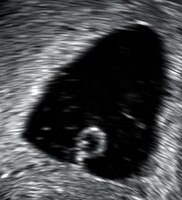
Photo from wikipedia
In this issue of Fertility and Sterility, Liu et al. (1) analyzed the effect of endometrial thickness (EMT) on ectopic pregnancy rate in frozen embryo transfer (FET) cycles. Ectopic pregnancy… Click to show full abstract
In this issue of Fertility and Sterility, Liu et al. (1) analyzed the effect of endometrial thickness (EMT) on ectopic pregnancy rate in frozen embryo transfer (FET) cycles. Ectopic pregnancy (EP) is an undesired outcome of in vitro fertilization (IVF) cycles and has significant medical, emotional and financial implications for the patients. Large studies that have analyzed more than 10 years of data in United Kingdom and United States show that the risk of ectopic pregnancy associated with IVF is 1.5% to 2%, and it has decreased over time (2, 3). This risk appears comparable to U.S. general population. However, the results of individual investigations vary and EP rates appear to be higher (2%-5%) in some studies mostly from China (4). There are many known risk factors for EP, including smoking, tubal disease, pelvic adhesions, previous ectopic pregnancy, multiple embryo transfer, fresh and cleavage stage embryo transfers. Liu et al. (1) performed a retrospective cohort study examining 17,244 FET cycles that resulted in pregnancy, from a single institution over 8 year time period. Liu et al. (1) concluded that, after adjusting for known risk factors of ectopic pregnancy, EMT remains a significant independent risk factor for EP. All analyzed cycles had EMT of at least 7mm on the day of progesterone start or the day of hCG trigger. EP rate was inversely proportional to EMT. Interestingly, medicated FET was associated with higher EP risk compared to modified natural or stimulated cycles. Large sample size is the strength of the study. Moreover, the data was collected in a single center which decreases differences in clinical and laboratory practices and reduces operator dependent variations in sonographic assessments. The evaluation of only FET cycles also avoids heterogeneity associated with fresh cycles. However, the study has several limitations, some of which are inherent to the retrospective design. In 785 cycles, there was either unknown outcome or no EMT data recorded. Omission of this missing data may introduce selection bias. Liu et al. (1) discuss that they did not have data on smoking which is a known confounder. Moreover, not all confounding variables may have been accounted for due to possible unknown factors affecting ectopic pregnancy pathogenesis. Liu et al. (1) define thin EMT as <8 mm in FET cycles, however, most prior studies define thin endometrium as less 8mm in fresh cycles and less 7 mm in FET cycles. This is an important clarification to make while interpreting the results of this study. However, this does not affect the results or proposed mechanism of ectopic pregnancy pathogenesis in the current study. Higher EP rate (3.15%) limits the generalizability of the study findings to Western populations, which have much lower EP rate after IVF as discussed above (1.5%-2%). Liu et al. (1) attribute higher EP numbers in this study to the
Journal Title: Fertility and sterility
Year Published: 2020
Link to full text (if available)
Share on Social Media: Sign Up to like & get
recommendations!